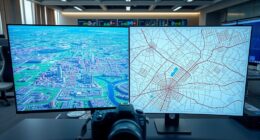AI pathfinding uses grid-based systems to map out environments, simplifying complex spaces into manageable cells. It applies algorithms like A* and Dijkstra’s to find the most efficient routes, dynamically adjusting as obstacles appear or move. The system recognizes barriers in real-time, updating the grid instantly to avoid blocked paths. This combination allows agents to navigate smartly and smoothly, even in changing environments, and if you keep exploring, you’ll discover how this process truly creates believable, adaptive movement.
Key Takeaways
- Grid navigation simplifies the environment into manageable segments for path calculation and movement.
- Pathfinding algorithms like A* evaluate nodes based on distance and estimated remaining routes for optimal paths.
- Real-time obstacle detection updates the grid, marking blocked cells to prevent agents from getting stuck.
- Dynamic rerouting allows agents to adapt instantly to new or moving obstacles, maintaining smooth movement.
- Combining grid-based navigation with obstacle avoidance creates realistic, efficient AI behavior in changing environments.

Artificial intelligence pathfinding is a critical component in creating realistic and efficient navigation for game characters and autonomous agents. When designing these systems, understanding how they navigate through complex environments is essential. One common approach involves grid navigation, where the environment is divided into a grid of nodes or cells. This method simplifies the world into manageable segments, allowing the AI to evaluate possible routes systematically. By breaking the map into sections, the AI can quickly analyze which paths are accessible and which are blocked, streamlining the decision-making process.
In grid navigation, each cell represents a point the agent can move to, and these points are connected to neighboring cells. The AI assesses the cost of moving from one cell to another, considering factors like distance or difficulty. When plotting a route, the system searches through these nodes to find the shortest or most efficient path to the target, often using algorithms like A* or Dijkstra’s. These algorithms prioritize nodes based on a combination of distance traveled and estimated remaining distance, guiding the agent toward its goal while avoiding unnecessary detours.
Obstacle avoidance plays a pivotal role in making navigation realistic. The environment isn’t always free of barriers, so the AI must recognize and respond to obstacles dynamically. When an obstacle appears along the planned route, the AI recalculates the path, avoiding the blocked cells and seeking alternative routes. This process ensures that agents don’t get stuck or behave unnaturally. Effective obstacle avoidance relies on real-time sensing and updating the grid, marking certain cells as impassable when obstacles are detected. The AI then reroutes around these blocked areas, maintaining smooth and believable movement.
Effective obstacle avoidance updates the grid in real-time, ensuring smooth, natural navigation around barriers.
Combining grid navigation with obstacle avoidance creates a robust system capable of handling diverse scenarios. The AI can efficiently traverse open spaces while adapting to sudden changes in the environment. For example, if a player blocks a pathway or a new obstacle appears, the AI quickly adjusts, rerouting around the obstruction without hesitation. This adaptability results in more immersive gameplay and autonomous behavior that appears intelligent and lifelike. Additionally, understanding environment complexity helps optimize the pathfinding algorithms for better performance and realism.
Frequently Asked Questions
How Do AI Algorithms Adapt to Dynamic Environments?
When faced with dynamic environments, your AI algorithms adapt through sensor integration and real-time processing. The sensors gather continuous data on changes around them, while the algorithms analyze this info instantly. This allows your AI to adjust its path or actions on the fly, avoiding obstacles or updating routes. By constantly processing new data, your AI stays responsive, flexible, and capable of steering through ever-changing scenarios efficiently.
What Are the Limitations of Current AI Pathfinding Techniques?
Ever wonder why AI pathfinding isn’t perfect? You’ll find that current techniques often struggle with complex, unpredictable environments, mainly due to limitations in heuristic optimization and obstacle avoidance. They can get stuck in local minima or fail to adapt quickly to sudden changes. These constraints mean AI might not always find the most efficient route, especially in dynamic settings where obstacles move or new paths appear unexpectedly.
How Does Machine Learning Improve Navigation Accuracy?
You see, machine learning improves navigation accuracy by analyzing sensor data and refining maps over time. It enhances sensor accuracy, reducing errors in obstacle detection, and boosts map resolution, making the environment details clearer. As a result, your AI system can make smarter decisions, adapt to new environments faster, and navigate more reliably. This continuous learning process guarantees the system stays up-to-date, leading to more precise and efficient pathfinding.
Can AI Pathfinding Algorithms Be Biased? How?
Picture a map with clear roads but hidden pitfalls. AI pathfinding algorithms can be biased if their training data or design favor certain routes or areas, leading to unfairness. Algorithm bias can cause some options to be overlooked, raising fairness concerns. You must guarantee diverse data and regular checks to minimize bias, helping the AI navigate more equitably and accurately, just like fixing a flawed map to guide everyone fairly.
What Future Advancements Are Expected in AI Mapping Technology?
You’re curious about future advancements in AI mapping technology. Expect smarter, more accurate maps that enhance autonomous vehicles’ navigation and urban planning. These innovations will incorporate real-time data, improve obstacle detection, and adapt to changing environments. This means safer autonomous driving and more efficient city designs. The focus will be on creating maps that learn and evolve, helping AI systems better understand complex urban landscapes and improve overall performance.
Conclusion
So, now you see how AI pathfinding isn’t just magic—it’s clever maps and algorithms working behind the scenes. Next time your virtual hero dodges obstacles effortlessly, remember: it’s not luck, it’s smart mapping. Who knew that tiny, invisible grids and clever calculations could outsmart even the most seasoned gamers? So go ahead, marvel at the digital geniuses—just don’t forget to thank the robots for making your gaming life so *easy*.









